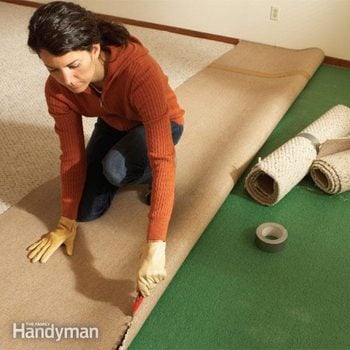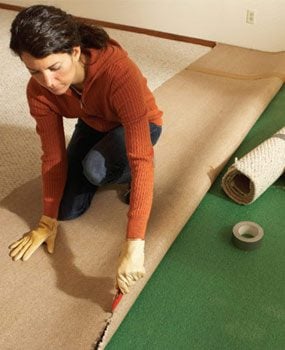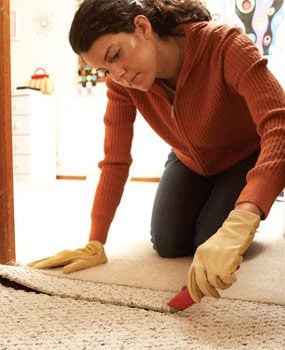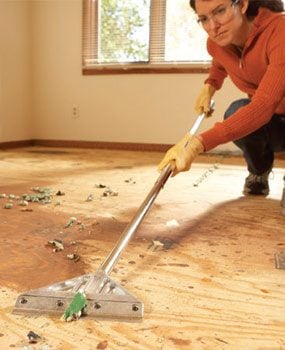Tips on How to Remove Carpet
Updated: Aug. 25, 2023Tips for faster, easier carpet removal.

Remove old carpet yourself and save!
Having new carpet installed? Removing the old stuff yourself is a smart move. Here’s how to remove carpet quickly and efficiently.
Before the tear-out
Talk with your installer to find out exactly how much you’ll save by doing the how to remove carpet project yourself. Your installer can also give you advice on handling any unusual situations in your home and what to do with the old carpet. Many trash haulers will accept short rolls of carpet along with the regular trash and some cities have carpet recycling programs.
Before you begin tearing up carpet, remove any doors that swing into the room, including bifold closet doors. Doors that swing into adjoining rooms can stay in place. Then clear the floor completely, removing all the furniture from the room. Slip on a pair of gloves to protect your knuckles from the abrasive carpet backing and the needle-sharp tack strip. There’s a lot of dust trapped inside old carpet. So if you’re sensitive to dust, strap on a dust mask, too.
How to Replace Carpet: Pull, cut and roll
To detach the carpet from the tack strip that holds the carpet in place along walls, start in a corner; just grab the carpet with pliers and pull. Then grab the carpet by hand and continue to pull it up along an entire wall. Fold back about 3 ft. of carpet and cut it into easy-to-handle strips (Photo 1). Carpet is much easier to cut from the back than from the front. Use a sharp new blade in your utility knife and be careful not to slice into baseboard or walls.
Keep pulling back the carpet and slicing it into strips. When you come to a “transition” where the carpet meets another section of carpet or other flooring, cut the carpet and leave the transition in place (Photo 2). If you have a metal transition that’s in good condition, the installer may decide to leave it in place. That can save you about $10 per transition. If the carpet is seamed to another section of carpet, the installer can separate the seam without damage to the carpet that’s staying in place.
To remove carpet from stairs, start at the top. If there’s a metal nosing at the top of the stairs, pry it up to remove it. If not, cut the carpet near the top of the top riser, grab the cut end and pull the carpet off the stairs by hand. Wear gloves to protect your hands from the staples that hold the carpet in place. Some stairs are covered with short sections of carpet that wrap over just one tread and riser. If you find yourself pulling up one long piece, slice off sections as you go to make pulling easier. When you’ve torn off all the carpet and pad, pull out all the staples with pliers.
Cut the pad into strips and roll it up just as you did with the carpet. On a concrete floor, the pad is glued in place, so big chunks of pad will remain stuck to the floor. To remove them, use a floor scraper. Long-handled scrapers cost about $30 at home centers. Shorter versions cost about $10. Some scrapers have razor-sharp blades; others have blunt blades. Either type works fine on concrete.
On a plywood or particleboard subfloor, you’ll have hundreds of staples to deal with. You can pull staples with pliers, of course, but that can take hours. With a sharp-bladed floor scraper, the job takes just a few minutes (Photo 3). The blade will shear off some staples and yank out others. Be sure to go over the whole floor so you don’t leave any behind. If the scraper digs into the floor, flip it over so that the blade’s beveled side faces down. If it still digs, work at a lower angle.
Trash the tack strip?
In most cases, you should leave the old tack strip in place, but there are a couple of exceptions: Remove any sections that are rotten, delaminating or badly rusted. Rust can “bleed” through the carpet, creating stains on the surface. You should also remove the tack strip if it’s less than 1/4 in. from the baseboard. The installer needs a gap at least 1/4 in. wide to tuck the edge of the carpet down against the baseboard. To remove tack strip, just pop it up with a flat pry bar. Tack strip is available at home centers (about 20¢ per ft.), but you’ll save very little money, if any, by installing it yourself.
Required Tools for this How to Remove Carpet Project
Have the necessary tools for this DIY how to remove carpet project lined up before you start—you’ll save time and frustration.
- Dust mask
- Knee pads
- Locking pliers
- Pry bar
- Safety glasses
- Utility knife



